 USA (1914) USS Nevada, Oklahoma
USA (1914) USS Nevada, OklahomaWW1 US Battleships:
USS Maine | USS Texas | Indiana class | USS Iowa | Kearsage class | Illinois class | Maine class | Virginia class | Connecticut class | Mississippi class | South Carolina class | Delaware class | Florida class | Arkansas class | New York class | Nevada class | Pennsylvania class | New Mexico class | Tennessee class | Colorado class | South Dakota class | Lexington classThe Nevada class: First “standard battleships”
The Nevada and Oklahoma marked a milestone in US Battleship design. Launched just before WW1 broke out, they were the world’s first to adopt the famous “all or nothing” armor scheme, quite a rationalization of armor protection tailored for long-range engagements. Two years later, as they were just being completed, the Battle of Jutland this was clearly shown as a useful layout, quickly adopted by other navies. The Nevada class was also introduced the first “standards” in a sense they adopted for the first time three-gun turrets solution to maximize the arc of fire and oil-fired water-tube boilers.
They were transitional in that sense, still with superfiring twin turrets. The standard was expanded to 4×3 and was repeated for next four classes battleships, clearly intended by the admiralty to be tactically homogeneous and form the ideal battle line, the “battleship row” in pearl Harbor in 1941. Both paid a heavy price as Oklahoma was sunk, her remains partially dismantled many years later. USS Nevada was also badly hit but survived, and after repairs and further modernizations had quite an active career in the Pacific until the end of the war.
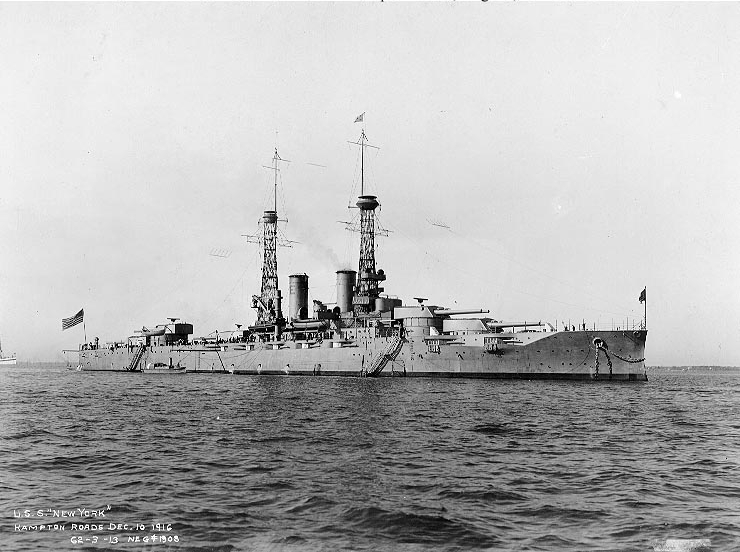
The previous New York class, in Hampton Roads.
Development of the Nevada class
Context: The standard is born of Congress opposition
When the ships were to be planned, there was a strong political opposition to continual growth and cost of battleship building in the congress since the dreadnought. The Navy settled on a program of two new battleships per year, endorsed by President Theodore Roosevelt. However in 1904, Congress changed and started to reject Navy’s requests, back to one ship per year or not at all. Howard Taft, one of the “falcons” and Roosevelt successor tried to bend the congress with little success. However he managed to obtain authorization for two capital ships FY1912. This was the Nevada class. However, Woodrow Wilson was elected in 1912, and immediately opposed the naval spending, endorsed by his Secretary of the Navy, Josephus Daniels blocked demands for larger and more powerful ships, and in exchange of two vessels per fiscal year, the admiralty made a compromise and accepted to stick to the same standard. Later, it was internally argued that this standard will allow an homogeneous battleline and to streamline tactics.
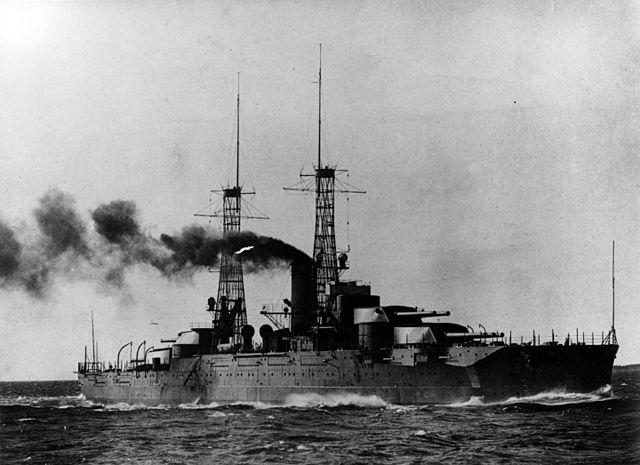
USS Nevada in trials, 1916
Design development
The General Board started with twin-gun turrets of earlier dreadnoughts as the arc of fire was not optimal but only in broadside. It was requested for the first time a move towards three-gun turrets. This configuration would allow less turrets, a better armour rationale, and better arc of fire. At first, the choice of twelve 14 in (356 mm) guns looks ideal. It was two more than the New York class, with four turrets. design work started for FY1912 two years prior, and the first sketch were prepared by the Bureau of Construction and Repair (C&R) in May 1910.
They were heavily based on the preceding New Yorks but the aft superfiring No.4 turret was removed and amidships No.3 turret in superfiring over the No.5 turret. This was similar to British battlecruisers of the time but was soon seen as a complicated arrangement, requiring an ammunition magazine between the engine and boiler rooms. Naval historian Norman Friedman suggested this could have been adopted to reduce an excessive weight aft, causing greater stress to the stepped the hull and requiring extra stiffening there, less weight available to armor protection. As usual the design provisioned also four torpedo tubes and a classic 5-in secondary of seventeen QF guns. As shown by the initial blueprints, the belt armor was 11 in (279 mm) thick.
Birth of the all-or-nothing armor scheme
Meanwhile the Navy’s think tank estimated that long range gunnery naval engagements would be the norm, reflected by the recent appearance of better armor-piercing shells and that the days of the high-explosive shells were counted. The latter could be dealt by medium armor of the new standard. In addition there was still no possibility to aim specifically at unarmored areas while AP shells would easily perforate medium armor and explode deep inside. The assumption of long range gunnery also as reflected in the adoption of a thick deck armor due to the increasingly parabolic trajectory of modern shells. Therefore the armored sides were a bit ignored at this point.
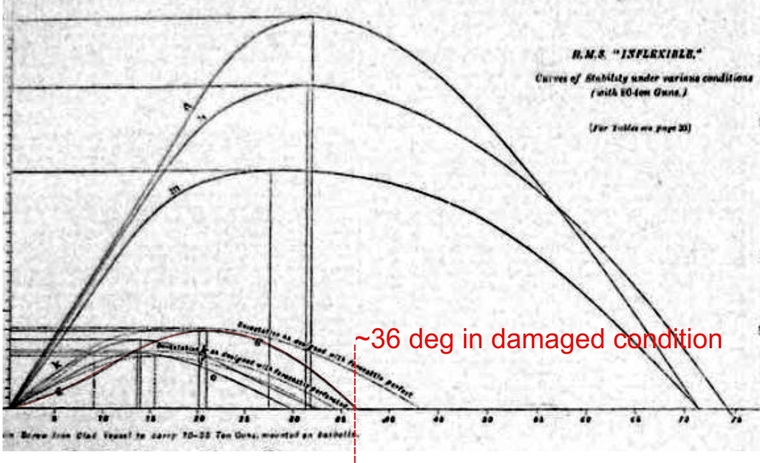
Ballistic studies about HMS inflexible. This illustrates the board’s discussions about long range gunnery that led to this armour scheme theory.
The logical result of these speculations led to the “all or nothing” logic. Basically this was a statistic-based assumption of what parts needed to be protected most and reserve this protection only for the ship’s vitals. This naturally comprised the ammunition magazines, powerplant spaces, and command areas (notably the CT). In addition it was made watertight, in order to design an “armored raft” allowing the ship to float even in case all the rest of the unprotected hull was flooded. It was calculated to contain enough reserve buoyancy. This was a breakthrough innovation for the time, a revolution in capital ship protection that will spread like wildfire outside the US, an soon reach cruisers as well. Therefore the Nevada class was the first in the world to inaugurate this radical protection scheme.
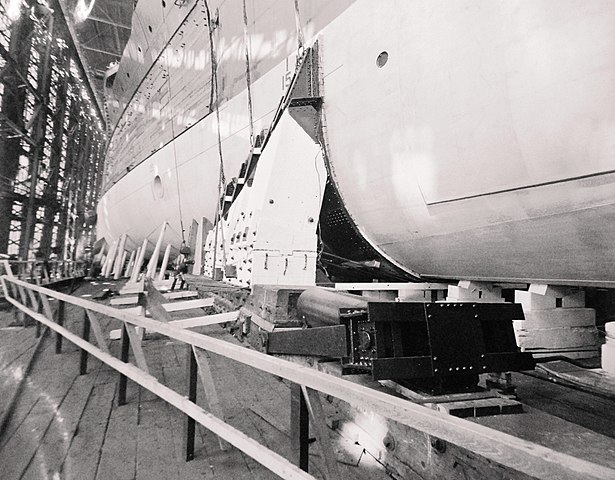
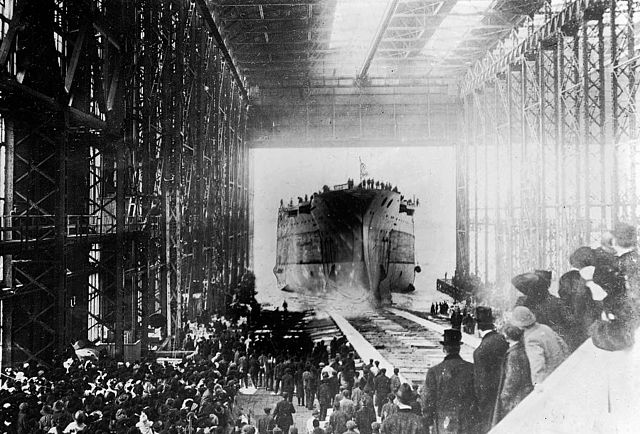
Launch of USS Oklahoma in NY Shipbuilding Co in March 1914.
Evolution of the design (June 1910-fall 1910)
In June 1910 the Admiralty Board sent new requirements to C&R, still requesting a twelve-gun battery but also a top speed of 21 knots (39 km/h; 24 mph) and crucially the “all or nothing” protection scheme they created. C&R engineers however reported that the heavy armor deck would indeed considerably strengthen the hull notably fo longitudinal strength and compensate for the barbette openings, but also pointed out the 11-inch belt armor was no longer able to defeat the latest main guns in development. The Board responded by conceding an extra 1.5 in (38 mm) splinter bulkhead backing the belt internally to contain shell fragments. By October-November 1910, the Navy submitted budget estimates for FY1912, planned for the Congress vote scheduling in 1911. Figures were based on the New Yorks and this was accepted by the Congress. But as a result, this imposed a displacement of 27,000 long tons (27,000 t) like the previous ships. Soon C&R’s protested it was too light and asked for a redesign, also incorporating experiences from service of the first USN dreadnoughts.
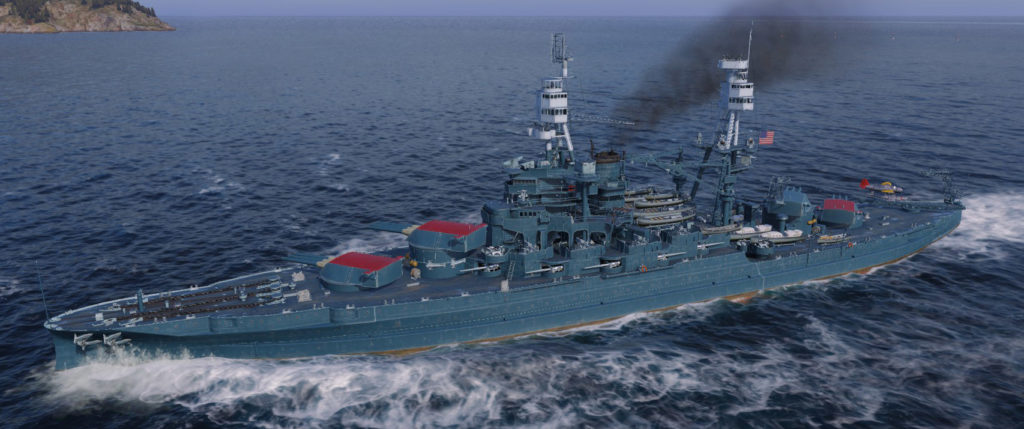
wow’s rendition – USS Oklahoma in 1941
C&R redesign, concessions and approval (1911)
C&R redesign changes were first to drop the the arrangement of the aft pair of turrets. However it was still not found at that stage superfiring triple turret arrangement was too heavy. It was decided to move away the amidships magazine close to the boiler rooms as it was difficult to keep cool, as shown on previous battleships. The thicker deck increased hull strength so C&R proposed a closely spaced aft superfiring pair. This allowed also to shorten the hull, reduce armor protection, and keep in the displacement limits. The Delaware reports about its propulsion of mixing coal and oil also brought out a simplification: Only oil fired boilers.
This radical option was found to procure a set of advantages:
-The ability to refuel at sea (with simple flexible pipes by navy tankers)
-A significant reduction in boiler room crews (no more stokers)
-A greater fuel efficiency (smaller tanks)
-More compact boiler rooms, making shorter space to protect.
C&R was internally divided on this issue on this issue as they thought the deep ASW protection relied on these coal bunkers backing the side armor. The Board however was enthusiastic and approved all these changes in November 1910. Engineers of C&R however continue to lobby for the New York class design, but the Board stuck to the latest revise proposal and decided to return on steam turbines in the they belief the notoriously voracious turbines would be better fed by more efficient oil for long range cruise in the Pacific.
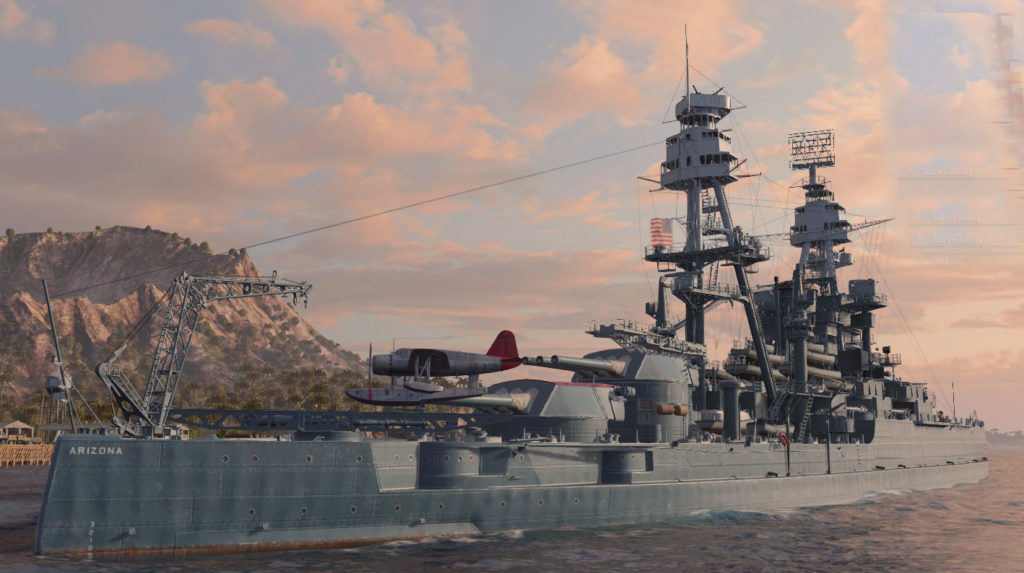
wow’s rendition – USS Nevada stern, 1941
C&R submitted its next proposal on 13 February 1911; it generally aligned with the Board’s ideas for the armor layout, but it retained some medium armor to protect the secondary guns and it incorporated triple-expansion machinery (though they noted that the engine rooms could accommodate Curtis turbines). The Board rejected it, leading the designers to remove the medium armor, producing a series of studies with speeds of 20 knots (37 km/h; 23 mph), 20.5 knots (38 km/h; 24 mph), and 21 knots and main batteries that ranged from eight to twelve guns. During this period, on 4 March, Congress authorized a pair of ships, designated BB-36 and BB-37 for FY1912. With the ships now authorized, the Board selected one of the ten-gun, 20.5-knot variations on 30 March, which had a belt that was increased to 14 in but included a series of tapers at the top and bottom edge to save weight. The Bureau of Ordnance pointed out that the belt could not be manufactured in a single strake with the tapers, so a joint between upper and lower strakes—a design weakness the engineers had been attempting to avoid—would have to be used. The problem was resolved in July, when C&R proposed removing the 1.5-inch splinter bulkhead in favor of increasing the belt to 13.5 in (343 mm) and incorporating only one taper at the lower edge.[8]
C&R and the board would then argued over the turret question. Four turrets would mad considerable weight savings and a thicker belt, correcting an observation of C&R about side protection. However the biggest concern was the Navy has until now never built a three-gun turret. There were concerns both at C&R and the board that a single hit could disable all three guns (something that will came to haunt proponents of a four-gun turrets in France in 1911 too !). It was also estimated that a triple opening in the face armor would make it weaker. C&R suggested making a model to be used on the old battleship Indiana, which was denied.
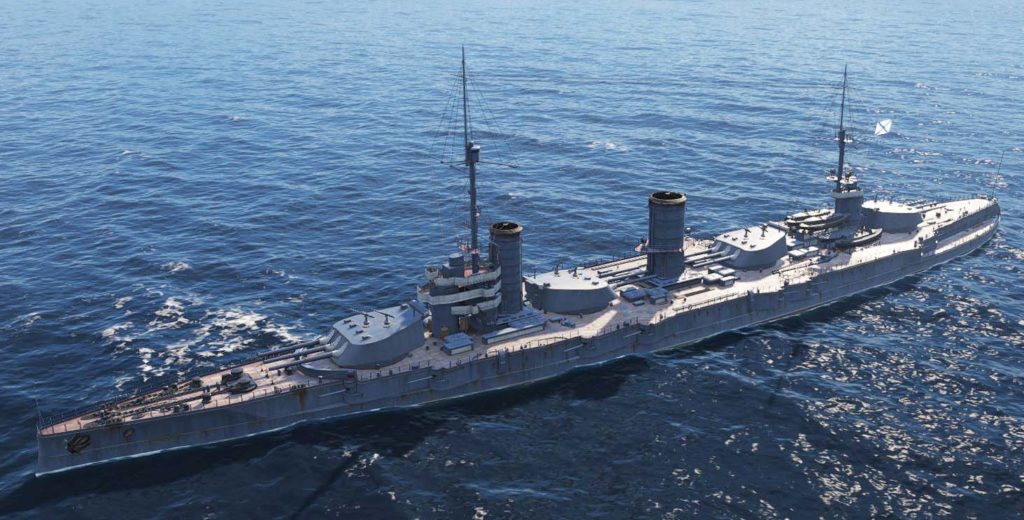
The Gangut shown using triple turrets was possible in a deck-level configuration only. But the limited displacement forced a superfiring solution in any case (wow)
Navy secretary J. Daniels meanwhile approved the Nevada final design on 31 March 1911, but as no turret design was ready then and many questions stayed in the balance. It was quite a gamble as this was an untested design, although many examples in Europe shown this seemed a way forward: Little they knew the Dante Aligheri, Gangut, and Tegetthof designs all gambled this already. The latter even gambled on superfiring turrets which was one step further away from the first two, which had long hulls to accomodate deck-level turrets only. C&R obtained to built an experimental turret in August 1912, which fired and proved the concept was sound but showed modifications were needed to reduce shell interference, also a crucial issue for accuracy. The finalized design compromised this by adopting a ten-gun battery: For the board this was a though pill to swallow, but the only realistic prospect was that only two turrets would be triple mounts on the deck, with superfiring twin-gun turrets (which was already a proven design).
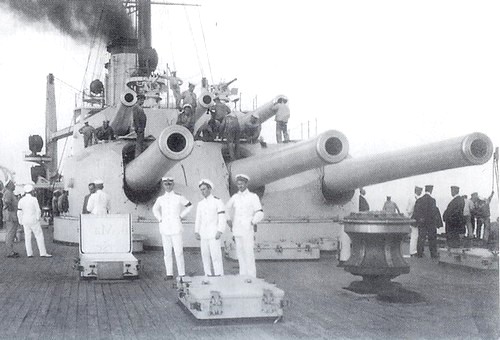
SMS Tegetthoff forward turrets. The Austro-Hungarians made the radical choice of triple turrets before everybody in order, like the Americans, to keep the displacement low due to their limited yard basin size. It is not known if US Intelligence reported this at that time.
At that stage the Board began made this design circulate among a large array fleet officers for returns. Captain John Hood (later a member of the Board) criticized the the secondary battery, already shown in service to be very “wet” to the point of being useless in rough seas. Due the torpedoes having a better range, it was found crucial to deal sooner with TBs and destroyers, and the fast 5-inch /51 caliber was too short range for this. But then, here was no suitable alternative, therefore the Board had little choice but to keep the initial battery. They could not by then foresee that rapid progresses in fire control would increase their accuracy greatly. This also avoided any complicated redesign which would added weight an delay the construction (as much heavier 6-in guns would have been a logical choice).
Design of the Nevada class
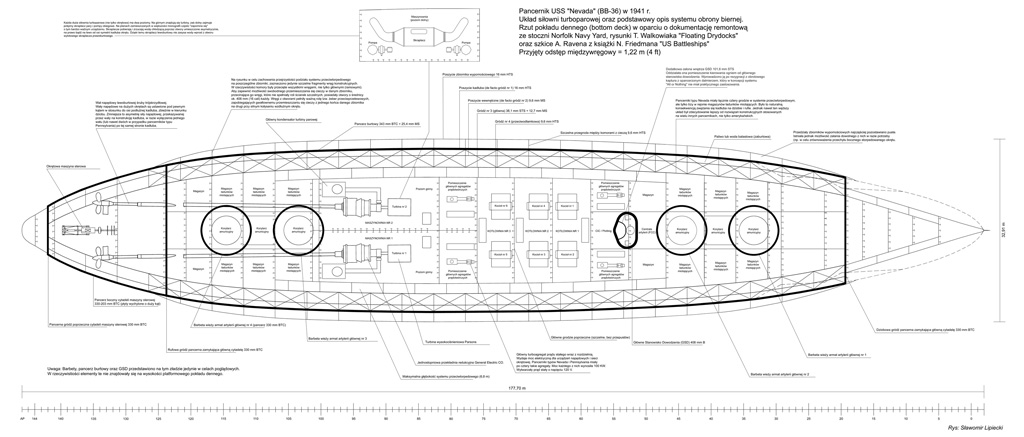
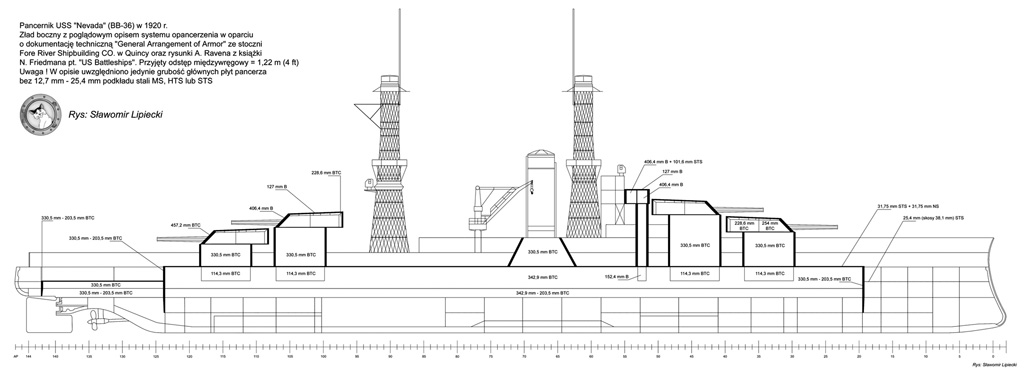
Reconstitution of the armour scheme by Slavomir Lipiecki SRC
Hull and all-or-nothing protection
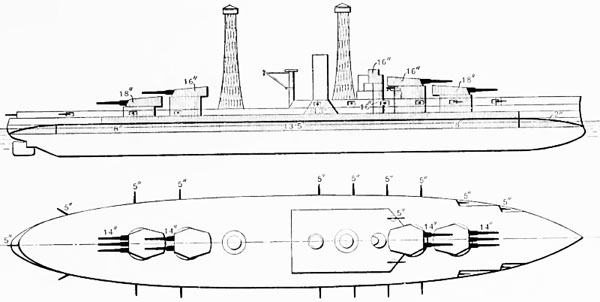
Brassey’s diagram of the Nevada armour scheme
The Nevada class BBs had a 575 ft (175 m) waterline long hull, 583 ft (178 m) overall, 95 ft 2.5 in (29 m) beam and 27 ft 7.6 in (8 m) draft (standard displacement), down to 29 ft 6 in (8.99 m) fully loaded, and the latter ranged from 27,500 long tons (27,900 t) as designed, 28,400 long tons (28,900 t) calculated fully loaded in service. Their ram bow was followed by a forecastle deck making around 50% of the ship’s length and superstructure were kept minimal to maximize the field of fire. There was an heavily-armored conning tower aft of the forward superfiring turret and two lattice masts behind, both supporting spotting tops.
The belt armor was 13.5 inches thick in between the outermost barbettes, protecting the magazines and machinery, 17 ft 4.6 inches or 5 meters wide, including 8 ft 6 in (2.59 m) underwater. It was reduced below to 8 in (203 mm). It was assumed that shells falling that far underwater to be slowed down enough. Both belt ends were connected by a transverse bulkhead 8-13 inches (330 mm) thick, created the citadel. Since it was all or nothing, both the bow and stern were unprotected.
The armored deck was 3 in (76 mm) but with a special treatment steel (STS), made in three layers. It made the top of the citadel. Further aft, it had a thicker stray of armour, 6.25 in (159 mm) over the propeller shafts. The armor deck connected to the top of the belt without slopes. There was below the secondary armored deck, made in nickel steel and 1.5 in (38 mm) thick, only there to contain splinters from the level above. Its sides were sloped down, and 2 in (51 mm) thick, connecting to the bottom edge of the belt, closing the citadel.
The main triple turrets (deck) faces had 18 in (457 mm) thick plates and 10 in (254 mm) sides, 5 inches roofs. The superfiring twin-gun turrets had (406 mm) faces, 9 in (229 mm) sides and all had 9 inches back plate. Barbettes had all 13 inches thick walls and the conning tower had 16 inches walls, and a 8 inches (203 mm) roof and it was made of STS armor. Boilers uptakes to the funnel had a protective conical mantlet 13 inches thick (340 mm).

USS Nevada during her sea trials
Powerplant; Shifting to oil-only
The Nevada class received direct-drive Curtis steam turbines, unlike previous ships. It was believed more oil would compensate for the consumption. They were fed by twelve oil-fired Yarrow water-tube boilers, and the class for the first time also had a pair of reduction geared cruising turbines clutched into the high-pressure turbines for fuel economy at low speeds. This also was a measure to reduce consumption.
This system really became a standard in all following US battleships to the exception of the late class using a turbo-electric arrangement. USS Oklahoma diverged from USS Nevada in having two vertical triple-expansion engines instead, plus twelve oil-fired Babcock & Wilcox boilers. This was a usual testing measure by the Navy to compare both ships propulsion system, and having at least one of the two with a reliable, known system. However USS Oklahoma’s reciprocating engines proved troublesome, generating excessive vibration. This was so bad that in 1925 the nav envisioned to replaced them by diesel engines but their excessive weight prevented this move. Also these ships diverged from the previous ones by having all their exhausts ducted into a single funnel, with its uptake well armoured.
Both ships had difference outputs as a result of their respective powerplants: 26,500 shaft horsepower (19,800 kW) for USS Nevada and 24,800 indicated horsepower (18,500 kW) for Oklahoma, but both were noted as capable of 20.5 knots as deigned. On speed trials, USS Nevada reached 20.9 knots (38.7 km/h; 24.1 mph) on an output figure of 26,291 shp (19,605 kW) on speed trials upon completion.
Also as design, their radius of action was 8,000 nautical miles (15,000 km; 9,200 mi) at 10 knots (19 km/h; 12 mph) but in reality it was in service 5,195 nmi (9,621 km; 5,978 mi) at 12 knots, and only 1,980 nmi at 20 knots. Nevada’s tactical turn to 180° took 825 yards or 754 m at 15 knots, down to 580 yards (530 m) at 19 knots and 625 yards (572 m) at 20 knots for USS Oklahoma.
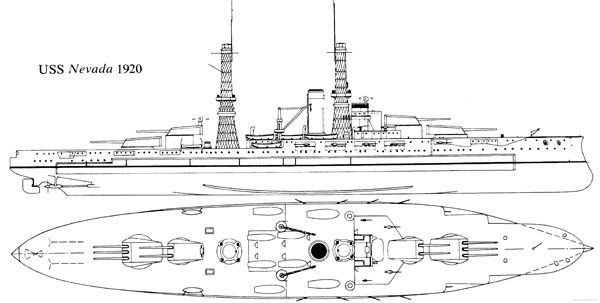
BB-36 Nevada overview in 1920. Many secondary guns has been retired already (hull), less those in the battery deck casemate.
Armament: Towards the 4×3 standard
Main Armament
The Nevada’s class main armament comprised ten 14-inch /45 caliber Mark III guns in a 2×3 – 2×2 superfiring arrangement. The triple turrets had their barrels supported by two trunnions so that they could only elevate as a single unit, not separately. These guns were supplied by 1,400-pound (635 kg) armor-piercing (AP) shells which existed the barrel at 2,600 feet per second (790 m/s). The close triple barrel arrangement showed excessive dispersion so practice dictated a successive fire, tenth of a second delay. The barrels elevated to 15 degrees and depressed to −5 degrees. The best range was 21,140 yd (19,330 m). The barrels were served by two shell hoists and the guns and loading system were all electric.
For fire control, the twin turrets were given roof armored rangefinders, and they were connected to the centralized fire control room in the conning tower. To complete this data also came from the main mast rangefinder, fore and aft.

wow’s rendition, USS Nevada in December 1941, on her way
Secondary Armament
It consisted in a secondary battery, twenty-one 5-inch /51 caliber Mark VIII guns. They fired a 50 lb (23 kg) shell, which exited the barrel at a muzzle velocity of 3,150 ft/s (960 m/s).
Twelve were in forecastle deck casemates, and the other six were in lower hull casemates, one more installed directly into the stern. In service, like for previous battleships, they were soon prove, excessively wet in rough sea. In later modernizations they were all removed. Two guns were in open mounts, mounted on the sides of the conning tower. Of course there was no lighter gun or AA.
Close Armament
As designed, both Nevada class had the customary 21 in (533 mm) torpedo tubes, both submerged in pairs in the broadside, below the waterline. They fired the new Bliss-Leavitt torpedoes Mark VII type. They had a 321 lb (146 kg) warhead and could reach 12,500 yd (11,400 m) at 27 knots (50 km/h; 31 mph), single setting available.
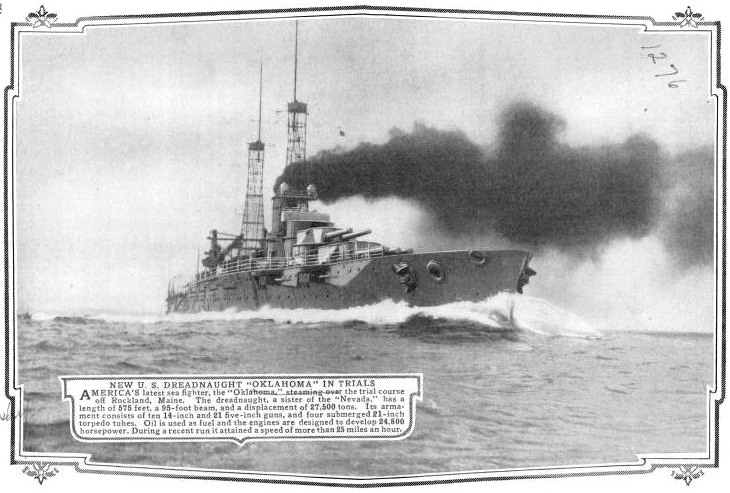
USS Oklahoma’s sea trials
Specifications in 1916 |
|
| Dimensions | 175 x 29 x 9 m – 573 ft, 95 ft, 29 ft |
| Displacement | 27,000 long tons standard, 28,367 long tons Fully Loaded |
| Crew | 1044 total: 55 officers, 809 enlisted men |
| Propulsion | 2 shafts VTE 14 water-tube boilers 28,100 shp (20,954 kW) |
| Speed | 21 kn (39 km/h; 24 mph) 7,060 nmi (13,080 km; 8,120 mi) |
| Armament | 10 × 14in (356), 21 × 5in (127), 4x 3pdr, 2x 1pdr, 2x 21in (533 mm) TTs sub |
| Armor | Belt: 10–12 in, casemate: 6.5–11 in, Barbettes: 10–12 in, Turrets 2-14 in, Decks 2 in, CT 12 in |
The Nevada class in service: WW1 and interwar
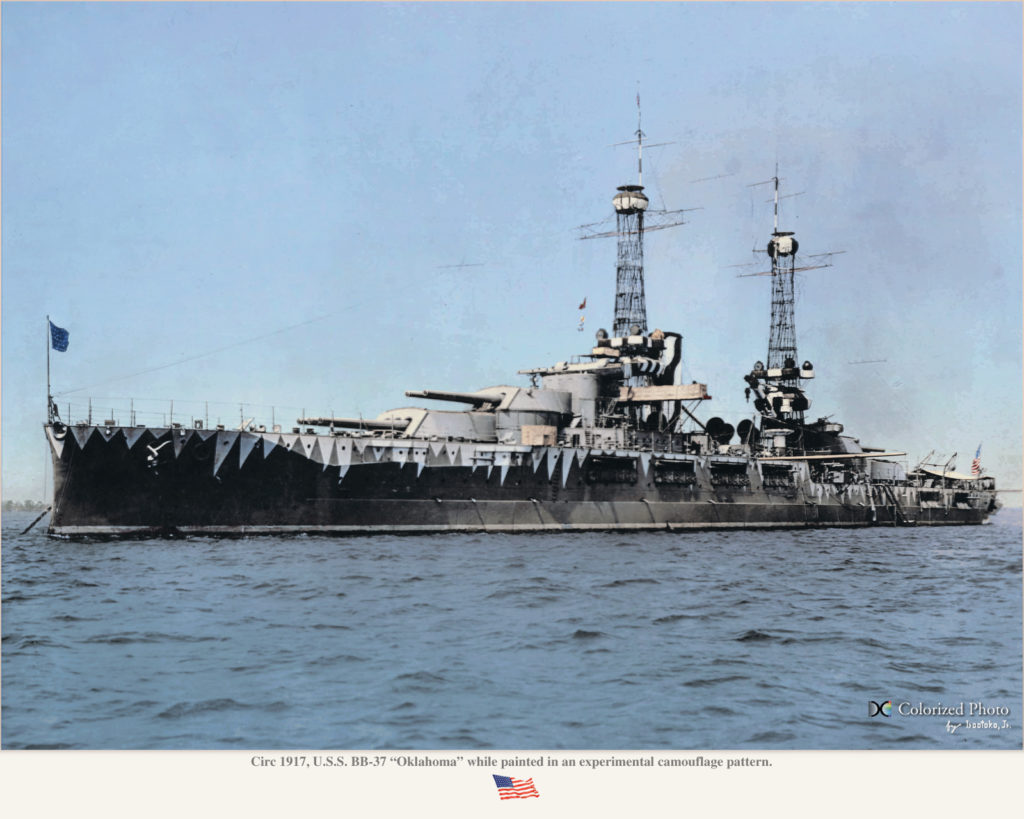
USS Oklahoma as experimentally painted with a disruptive pattern in 1917 – Colorized by Irootoko Jr.
USS Nevada and Oklahoma 1916-1920
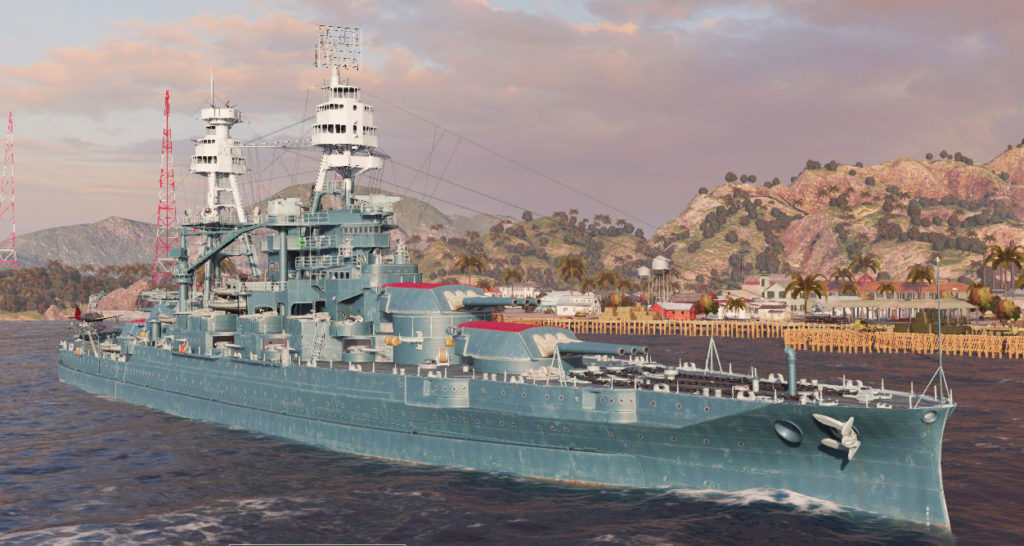
Wow’s rendition of USS Oklahoma in 1941
After fitting out in Boston, and later in New York Navy Yard, USS Nevada first served with the Atlantic Fleet based in Newport, Rhode Island. Her service started on 26 May 1916 with training cruises and exercises off Norfolk, Virginia. She made trips to the Caribbean. When the US entered the war in April 1917, there was a shortage of fuel oil in Britain so Nevada was not sent with Battleship Division 9 (BatDiv 9) made of VTE coal-burning Delaware, Florida, Wyoming, and New York. Instead, she was planned to join the British Grand Fleet on 7 December 1917, 6th Battle Squadron. however it’s only on 13 August 1918 USS Nevada departed for Britain, the last US BB to do so, seeing little action as expected.
She arrived in Berehaven (Ireland) on 23 August, joining Utah and her sister ship Oklahoma, the “Bantry Bay Squadron”, officially Battleship Division Six (BatDiv 6). The squadron was under command of Rear Admiral Thomas S. Rodgers. The battleships escorted the largest, most and valuable convoys in case German capital ships would slip through the British Grand Fleet and fall on the convoy by another route. This never happened so the battleships never fired a shot in anger. From 11 November, USS Nevada, now was under command of William Carey Cole, taking service until 7 May 1919). On 13 December 1918, she was part of a fleet of 10 battleships, including her sister ship, that escorted the SS George Washington, the liner carrying president Woodrow Wilson to Brest for the Paris Peace Conference. They sailed for home the next day and arrived in NYC in two weeks, in time to participate to a naval review linked to victory parades and celebrations.
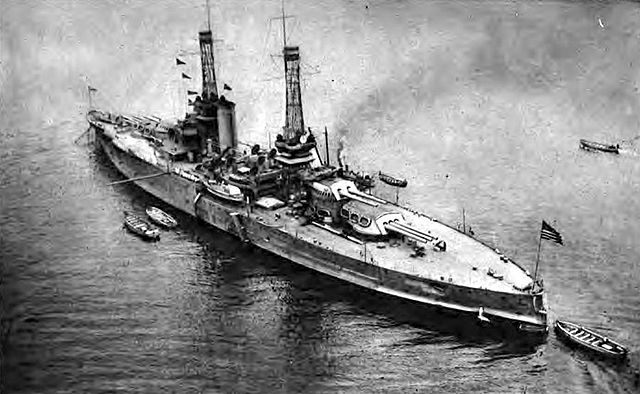
USS Nevada WW1
USS Oklahoma like other ships of BatDiv 6 only was only called out once in 80 days. On 14 October 1918 (capt. Charles B. McVay, Jr.) she escorted troop ships back from UK on 16 October and the remainder of her days in harbour, conducted drills at anchor in Bantry Bay. Crews played American football and competitive sailing, but six later fell ill from the Pandemic flu around the 2 November. USS Oklahoma stayed off Berehaven until 11 November 1918 but in the wake of the victory, crewmembers fought with members of Sinn Féin, and the battleship’s captain was obliged to paid for the damage and made public excuses to the mayors of nearby Bantry bay towns.
USS Nevada: The interwar
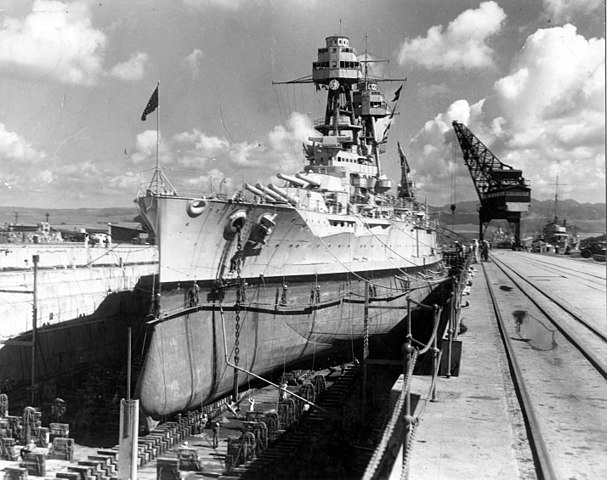
USS Nevada in drydock, 1935
In 1919, USS Nevada was transferred to the Pacific Fleet and USS Oklahoma joined her in 1921. Nevada’s captain was Thomas P. Magruder from May to October 1919, William Dugald MacDougall (until 4 May 1920) in the Atlantic and Pacific Fleets. In 1920, Nevada was taken in hands for a short drydock refit: Her 21 five-inch (127 mm)/51 cal guns were cut down to twelve already in 1918, due to the hull casemate guns being “too wet”. Only the battery superstructure guns were kept, plus the two deck guns abreast the conning tower. Nevada new captain was Luke McNamee (until 19 September 1921). She sailed with USS Arizona to represented the United States at the Peruvian Centennial Exposition (July 1921). Douglas E. Dismukes took command in turn until 30 December 1922 and USS Nevada teamed with USS Maryland to escort back to South America the SS Pan America carrying Secretary of State Charles Evans Hughes to attend the Centennial of Brazilian Independence. Both ships were in Rio de Janeiro from 5 to 11 September 1922, and legend has it that baseball was made popular when Nevada’s crew was on leave in the city.
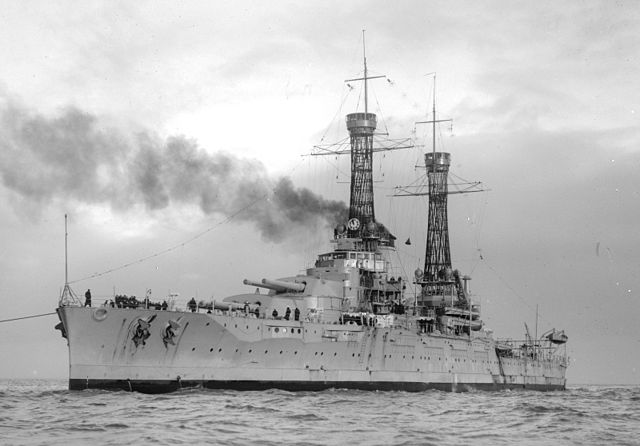
USS Nevada in 1925
By the fall of 1922, John M. Luby took command, until 7 September 1924, replaced by David W. Todd, until 11 June 1926. Meanwhile USS Nevada took part in a “goodwill cruise” to Australia and New Zealand in 1925. The cruise was hampered by the lack of supply points and demonstrated to naval powers of the pacific that the US was now able to project her battlefleet in the transpacific area of operations, being able in theory to confront the Imperial Japanese Navy in home waters for a possible “decisive battle”. This also changed naval scenarios and games in the US naval academy.
Nevada class modernization
Clarence S. Kempff took command in 11 June 1926 and would serve until 20 September 1927 as the ship was conducted in the Norfolk Naval Shipyard for modernization. It would last until 1930, under command of Hilary H. Royall (until 12 July 1930). The rebuilt was comprehensive:
-Corbel masts replace by tripods
-Steam turbines from cancelled USS North Dakota installed, geared turbines to increase range.
-Original Yarrow boilers replaced with 6 Bureau Express and new arrangement
-Main guns elevation increased to 30° (23,000 to 34,000 yards (31,100 m)
-Anti-torpedo bulges added
-Two catapults added: Three Vought O2U-3 Corsair spotter.
-Eight 5 in (127 mm)/25 tertiary DP guns added
-New superstructure installed, some 5 inch (127 mm)/51 relocated there as in New Mexico class.
USS Nevada afterwards joined the Pacific Fleet and stayed there until the attack of Pearl Harbor under command of John J. Hyland (until 30 April 1932), then William S. Pye (4 December 1933), Adolphus Staton (25 June 1935), Robert L. Ghormley (23 June 1936), Claude B. Mayo (2 October 1937), Robert Alfred Theobald (10 May 1939) and Francis W. Rockwell.(until 4 June 1941)

HD Cutaway of USS Okhahoma in the 1930s
Specifications (Nevada) in WW2 |
|
| Dimensions | Same but width beam 32.3 m (106 feets) |
| Displacement | 32,000 – 33,000 tons FL after refit 1926 |
| Propulsion | 6 × Bureau Express oil-fired boilers |
| Speed | 19.72 kn (23 mph; 37 km/h) |
| Armament | Same but 12×5 in/51, 8×5 in/25 8 × 0.5 in (13 mm) Browning 0.3 1944: 6×5 in/51, 10×3 in/50, 10×quad 40 mm Bofors, 44×20 mm Oerlikon |
| Armor | Same but turrets top extra 1.75 in (44 mm) |
Read More/Src
Models:
Tom’s Modelworks: Nevada 1941 & 1945
HP-Models USS Nevada BB-36 (1945) 1/700
http://www.steelnavy.com/HPNevadaCM.htm HP models review
http://www.modelshipgallery.com/gallery/bb/bb-36/350-ra/index.htm
1/350 resin, PE brass USS Nevada BB36 Dec. 1944*
1/820 70782 Lindberg USS Arizona and USS Nevada ‘Attack on Pearl Harbor’ with Diorama Sea Base
*By iron shipright
USS Oklahoma in service: The interwar
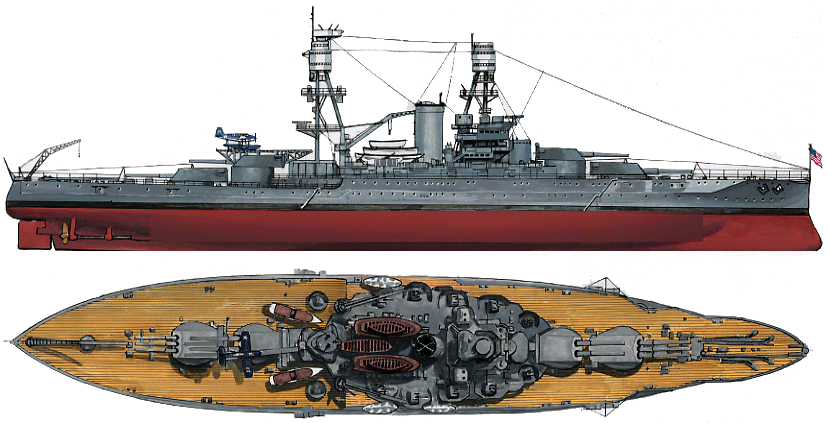
Author’s 2 views illustration of the Nevada in Dec. 1941
USS Oklahoma joined USS Arizona in Portland on 30 November 1918 and Nevada joined them on 4 December to form Battleship Division Nine, assigned as a convoy escort for the ocean liner SS George Washington carrying President Woodrow Wilson to France. After a trip back home to New York City in early 1919 she conducted winter battle drills off Cuba and by June returned to Brest, to escort Wilson back to New York. She Oklahoma was overhauled afterwards, her secondary battery reduced as her sister and in cruised to South America’s west coast for combined exercises with the Pacific Fleet and attended the Peruvian Centennial in 1923. She then joined the Pacific Fleet in 1925 for a training cruise from San Francisco to Hawaii for war games.
She then departed Samoa, crossing the equator and arrived in Australia for more exercises and stopped in New Zealand. In early 1927, she joined the Atlantic Scouting Fleet but by November, entered the Philadelphia Navy Yard for an extensive overhaul like her sister ship. She was then back with the Scouting Fleet for exercises in the Caribbean, and West Coast again via Panama in June 1930. The Fleet operations routine lasted until the spring of 1936 and that summer, she carried midshipmen on a European tour and was on guard duty during the civil war in Spain, stopping at Bilbao in July 1936 to rescue American citizens and other refugees and bring them to Gibraltar and French ports. She returned to the pacific on 24 October 1936.
For the next four years she participated in many exercises including the Army, Air force, and training reservists. USS Oklahoma by December 1937 was based in Pearl Harbor and multiplied patrols alternated with exercised and was back in USA, entering Puget Sound Navy Yard yard twice, to have extra AA artillery and armor installed, the last time in February 1941. She was to have her armour replaced and upgraded in San Pedro by mid-August but was struck by a severe storm and the next morning lost her starboard propeller. She sailed to San Francisco for repairs and stayed in drydock until mid-October 1941. She then sailed back to Hawaii, but according to the Washington Treaty she was planned for retirement on 2 May 1942.
USS Oklahoma during WW2
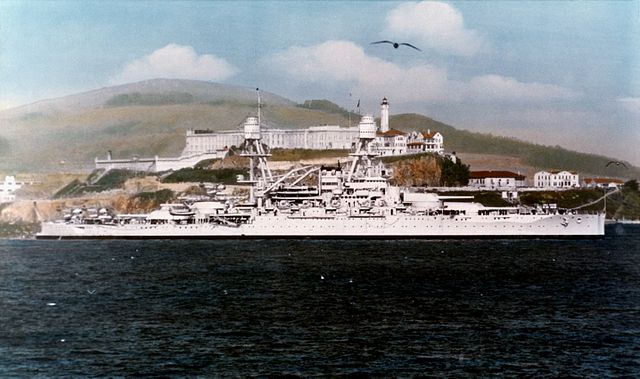
USS Oklahoma off Alcatraz in the 1930s
Oklahoma was moored in berth Fox in the battleship row 5 on 7 December 1941, when the attack started, alongside USS Maryland. In fact she protected her on her flank. She was the object of Akagi and Kaga torpedo planes first, and hit three times seconds apart. On hit 20 feet (6.1 m) below the waterline near the mainmast position, blewing up the anti-torpedo bulge, spilling oil from ruptured fuel bunkers sounding tubes but the hull beyond remained intact. Irony was the men scrambled to fire the AA only to find their that firing were under lock and key in the armory. The time for them to get there and be operational, the first wave was over. The third torpedo struck at 08:00 near Frame 65 and this time it penetrating the hull, ruptured the fuel bunkers and access trunks to the two forward boiler rooms and the transverse bulkhead to the aft boiler room so flooding began.
USS Oklahoma started to capsize to port when two more torpedoes struck while the bridge was strafed by Zero fighters, so the men were compelled to abandoned ship. About twelve minutes later she she rolled over completely, her masts scrapping the bottom, until he keel was exposed, taking possible one or two more hits in the meantime. The crew had time to evacuate for the most fortunate and went on helping other ships, starting manning AA on USS Maryland. In total, the ship lost 421 officers and men, many missing, trapped inside later drowning as the ship slowly filled up. Efforts to rescue them started quickly but dragged on into the night, it took hours. Nevertheless, some attempts worked, such as Julio DeCastro, a civilian yard worker which saved 32, cutting open the very thick hull with pneumatic jackhammers, crowbars and maces. The problem was that trapped air escape and the volume was taken by water, further raising levels, and stored fuel tanks needed to be avoided to avoid further spills or explosions.
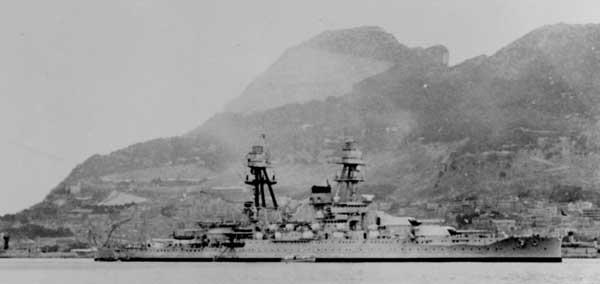
USS Oklahoma off Gibraltar in april 1936
They were remembered: Ensign John C. England for example had two USS England, DE-635 and DLG-22 named after him, as USS Stern, USS Austin. Austin posthumously was awarded the Navy Cross, while Ensign Francis C. Flaherty and Seaman James R. Ward had the medal of honor, and more Navy and Marine Corps Medals were awarded to other members of the crew.
The ship was a hazard for navigation and obviously needed to be salvaged. An assessment was done in early 1942, but it was cost-prohibitive. Eventually work started gradually on 15 July 1942, under command of Captain F. H. Whitaker. First she was to be righted up, and this step took eight months with was pumped inside, divers installing improvised airlocks until 20,000 tonnes of water was pumped out, using the torpedo holes. To avoid the ship to slide, 5500 of coral soil solidified her bow while two barges controlled the ship’s rise. The lifting operation was made using
21 derricks, attached to the upturned hull. Their high-tensile steel cables were actioned by massive hydraulic winching machines ashore. The “parbuckling” operation was completed on 16 June 1943 while divers and special teams had the gruesome task of removing human remains.
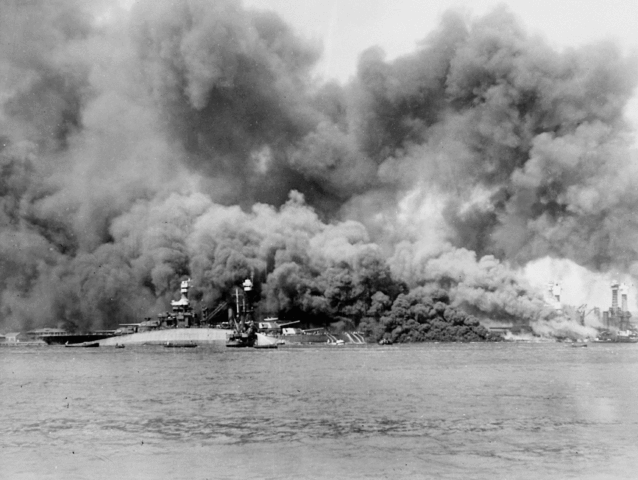
USS Oklahoma burning in Pearl Habor
In the end, the hull was inserted into cofferdams to allow basic repairs, patch the hull. On 28 December 1943, UDD Oklahoma was towed into drydock No. 2, Pearl Harbor NyD, and her main guns, powerplant and what was left of her stores and ammunition were all removed. Further damage was repaired and she was moored later, but due to the damage and priorities, it was understood she would not be modernized as her sister ships, the damage was too great. She was therefore decommissioned on 1 September 1944, her superstructure entirely removed when the war ended and she proposed for auction at Brooklyn NyD on 26 November 1946, sold to Moore Drydock Co. of Oakland, California, then by May 1947, and was to be towed for scrap.
The company had to had her moved from Pearl Harbor to the San Francisco scrapyard but Disaster struck on 17 May, both tugs being caught in a storm circa 500 miles (800 km) from Hawaii. It was discovered the ship had begun listing heavily and to avoid the tugs to be carried down when the ship would probably sink, they were radioed to head back to port. However in between the tugs already were dragged backwards at 15 knots as Oklahoma started to sink straight down, but the tug skippers ordered to loosen the cable drums and drop them completely at the very end.
The hulk’s position remained unknown. Dredging operations took place in 2006 by the US Navy, which recovered parts of Oklahoma still in Pearl Harbor, portion of the rear fire control tower support mast, later transported to the Muskogee War Memorial Park in 2010, now on permanent outdoor display. The ship’s bell and two screws are now on display at the Kirkpatrick Science Museum in Oklahoma City and her aft wheel at the Oklahoma History Center.
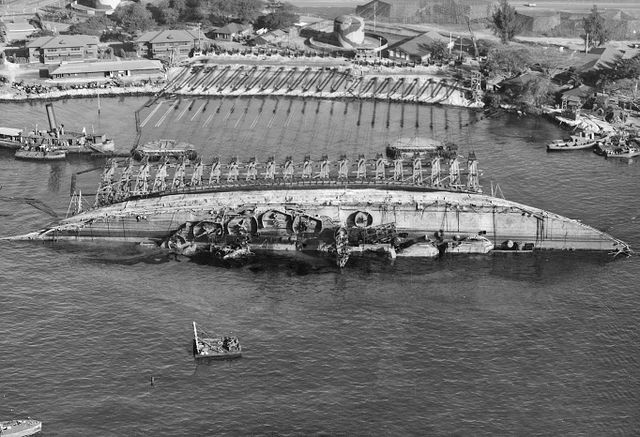
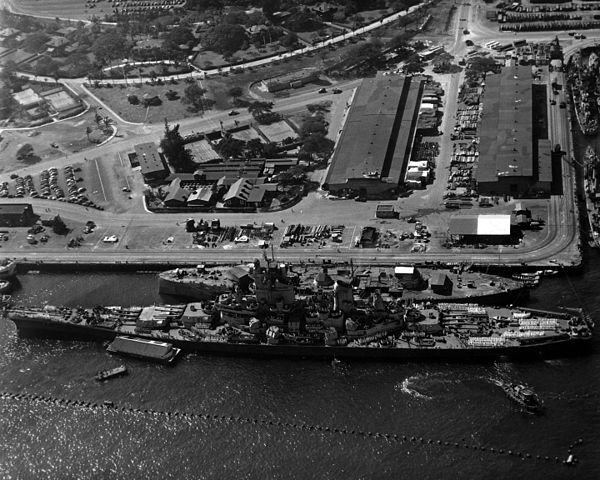
USS Okhahoma being refloated and righted, and waiting for her faite, moored alongside USS Wisconsin after the war
On 7 December 2007 a memorial for the Oklahoma’s 429 crew members as erected at Ford Island, nearby USS Missouri. Only 35 missing sailors and officers were later identified but 388 were not, and they were interred as such in the Nu’uanu and Halawa cemeteries, disinterred in 1947 for more identifications, helping properly burying 45 of them at the National Memorial Cemetery of the Pacific. In 2015, the DoD announced a new exhumation to be done, for DNA testings. By December 2017, 100 more had been identified and by the next year, 181, sent to their families by the Defense POW/MIA Accounting Agency. In December 2019, the 236th unknown was identified, leaving 152 still unknown for the future. The last survivor of USS Oklahoma, Ed Vezey, passed out aged 95.
USS Nevada during WW2
Sinking at Pearl Harbor and repairs
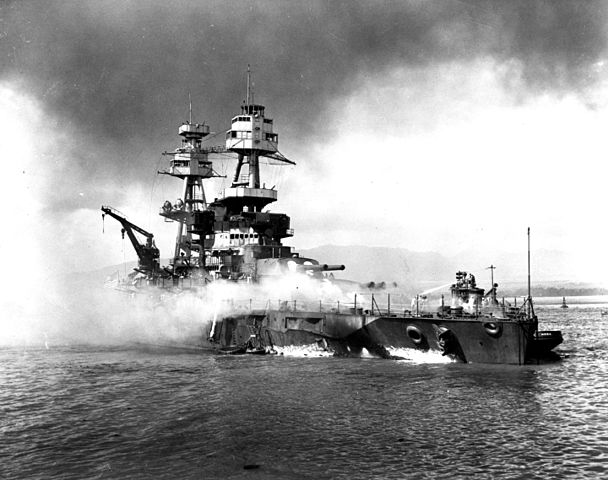
USS Nevada beached on Hospital Point
Back to Nevada: On 6 December 1941, USS Nevada was in port for the weekend, anticipated quite, since 4 July. Vice Admiral William S. Pye Task Force was granted this weekend leave whereas it has been scheduled to operate with Vice Admiral William Halsey, Jr.’s aircraft carrier task force. But the latter did not want to have his carriers slowed down and declined to be escorted by the battleships, a fateful decision. Halsey indeed steamed up to reinforce Wake Island’s Marine detachment with extra aviation. On the 7th, USS Nevada band was playing “Morning Colors” just as planes were spotted on the horizon.
USS Nevada was in line at the end the battleship row, off Ford Island, not exactly ready to manoeuver, but aft of Arizona. Commanding officer Francis W. Scanland (in service until 15 December) was ashore as the first bombs dropped. Ensign Joe Taussig on duty just ordered a second boiler lit off, gradually warming up the engines. Nevada’s gunners scrambled to action as alarm went on, opened fire whereas engineers rushed to raise steam. Soon, a Kate TB plane dropped a single 18 in (460 mm) Type 91 Mod 2 torpedo, which hit Frame 41 below the belt, 14 ft (4.3 m) above the keel. It was 08:10 AM, and just after she was shot down by the battleship’s own gunners. The torpedo bulkhead however did its job, but there was serious leaking which caused the flooding of port side compartments, below the first platform deck. The ship started to list 4–5° but damage control crew managed to stop it, by counter-flooding. Nevada at 0840 had her engines fed by steam and started her departure while her gunners allegedly shot down four more planes. Ensign Taussig’s saved his ship but lost a leg in on of the strafing attacks. As soon as she was underway, Nevada became however a moving target.
Japanese Aichi “Val” dive bombers of the second wave quickly concentrated on her. Pilots intended to sink her in the channel to block the harbor, carrying 250 kg bombs, but channel’s width of 1200 feet would have made this effort not successful. However about 09:50, USS Nevada was hit by five bombs in close succession. The first exploded above the crew’s galley, anoher the port director platform and down to the stack on the upper deck. Another hit the first forward triple turret on the port waterway. Large holes were blown up in the upper and main decks. Two more struck the forecastle, another failed to exploded in between decks, but another blew near the gasoline tank wich started to leak badly. Fire spread rapidly.
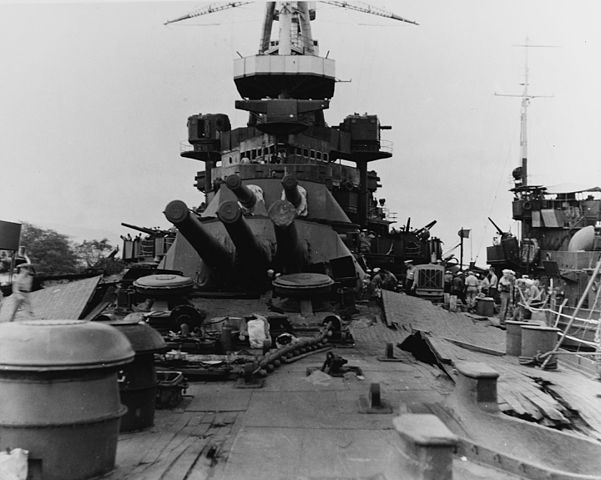
Bow assessement of Nevada’s damage
Gasoline fires around Turret 1 fortunately led to nothing as the main magazines were empty as the battleships were just about to underwent a swap to a new heavier projectile. The new powder charges were planned to be loaded on this Sunday. That was another strike of luck for the ship. USS Nevada however was now crippled and ordered to proceed west of Ford Island to ground her, which was done off Hospital Point at 10:30. She was assisted by USS Hoga and Avocet and her crew meanwhile shot down three more planes. The ship gently touched the bottom straight, quickly flooded thanks to the lack of watertight subdivision between the second and main decks. Water then started to enter through bomb holes and both the dynamo and boiler rooms were flooded soon.
During the attack, Nevada deplored 60 killed and 109 wounded and later two more men would die aboard during salvage operations two month later. They were poisoned by hydrogen sulfide gas, emanating since December from decomposing paper and meat. The damage party later assessed she could have been hit by as much as ten bomb hits. Refloating and repair the ship would take time however.
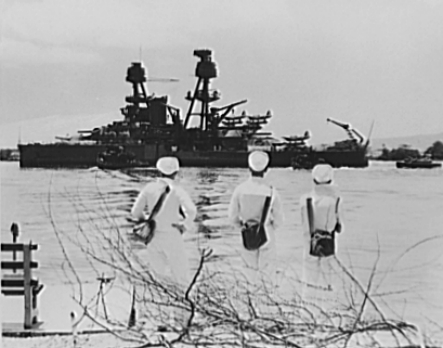
USS Nevada leaving Pearl for major repair and modernization in 1942
Repairs
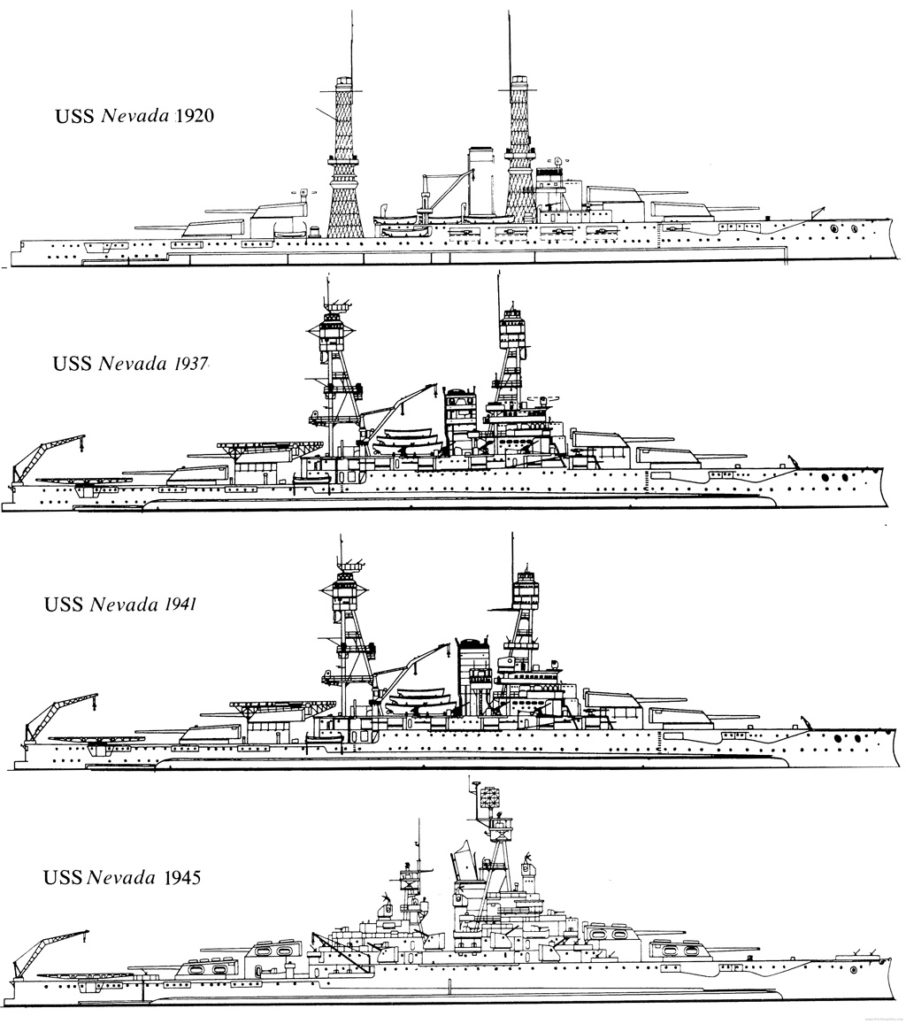
Various appearances of USS Nevada throughout her operational life.
On 12 February 1942 under Harry L. Thompson command, the battleship was refloated by using pumps, and temporarily repaired at Pearl Harbor, sent to Puget Sound NyD for drydock repairs. Her state was evaluated by the commission as positive for a modernization. It happened under command of Howard F. Kingman and completed in October 1942. She resembled USS South Dakota after this. The work consisted in replacing the main bridge superstructure by a thinner, lighter and taller one with open decks, rebuilt exhaust trunks into a new taller, raked funnel, relocation of the aft tripod mast further forward to gain arc of fires, deletion of the all 5″/51s and 5″/25s guns, replaced with sixteen 5″/38 caliber guns in new twin mounts, and considerable number of quad 40 mm and single 20 m Oerlikon guns, radars and modernized fire control systems. Willard A. Kitts took command on 25 January 1943, until 21 July 1943 leading the ship for her first new career operation, providing fire support from 11–18 May 1943 for the capture of Attu.
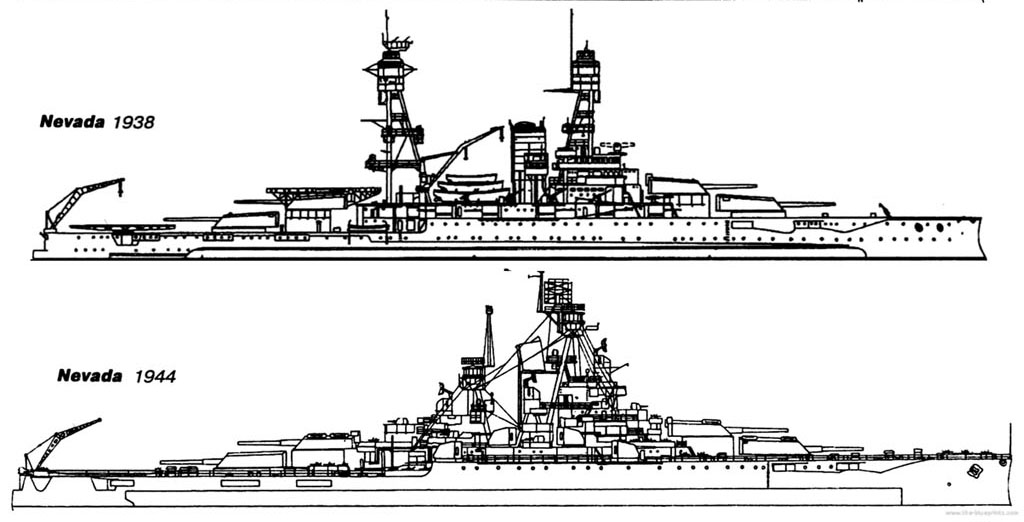
Details of the post-pearl harbor reconstruction, which was quite radical, but fast. USS Nevada was ready on time for D-Day.
D-Day campaign
USS after the Attu and Kiska capaign, was back in Norfolk Navy Yard in June 1943 for further modernization an when completed, departed for Atlantic convoy escort duties. She escorted convoys in a remote chance a German capital ship would raid it, but it never happened. Only on the northern route, towards Murmansk, German raids from Norway were attempted.
She made convoy runs throughout 1944, until send in in preparation for the Normandy Invasion by April 1944. Powell M. Rhea had by then taken command since 21 July 1943. In fact, the choice was not hard as she was the only battleship present both at Pearl Harbor and available for the Normandy landings. Her floatplane observer pilots were assigned to VOS-7, flying Spitfires from RNAS Lee-on-Solent. USS Nevada had the honor of being chosen by Rear Admiral Morton Deyo as his flagship for the operation. From 6 to 17 June she bring precious artillery support inland, departed for supply in UK and came back on 25 June to resume fire, moving to shell coastal defenses in the Cherbourg Peninsula, as far as 17 nmi (20 mi; 31 km) inland. The Germans however made counterbattery fire and she was near-missed 27 times. Her fire was estimated by the troops “incredibly accurate”.
Operation Dragoon
In August, the allies prepared the second landing, in the south of France, so USS Nevada was sent in the Mediterranean for such operation. To support the landings of Operation Dragoon she teamed up with four battleships, USS Texas, Arkansas, HMS Ramillies, Free French Lorraine, and three US heavy cruisers escorted by many destroyers. Many landing ships and craft used at D-Day were also transferred for the operation. Nevada started operation on 15 August and until 25 September 1944, she duelled with “Big Willie”, the most fearful German coastal fortress boasting four 340 mm (13.4 in) guns in two twin turrets, salvaged from Provence scuttled earlier in Toulon. The battery reached 19 nautical miles (35 km) and commanded every approach to Toulon and in addition to concrete, was reinforced by heavy armor plate embedded into the rocky sides of the island of Saint Mandrier. USS Nevada pounded the fortress, but she was not alone to do so from 19 August. This was combined to low-level bomber strikes. In all, Nevada fired 354 salvos at the fort. Toulon eventually fell on the 25th, but the fort held until the 28, eventually captured by ground troops.
Iwo Jima
Before proceeding into the pacific, Nevada was back to New York for a gun barrels relining, as they were quite worn out by that stage and the three Turret 1 main guns were comletely replaced with Mark 8 guns models from USS Arizona which were in a relining process in december 1942 and were left in storage since, to Mark 12 specifications. Homer L. Grosskopf took command on 4 October 1944 and USS Nevada arrived off Iwo Jima on 16 February 1945, commencing the preparatory artillery cover. The heavy bombardmen went on until 7 March and as the invasion took plane, she moved closer from shore, at 600 yd (550 m) to provide a more precise firepower at any troop’s command.
Okinawa
24 March 1945: Nevada was with Task Force 54, called “Fire Support Force” sent off Okinawa for shelling the island prior to the landings. TF 54 moved into position during the the night of the 23rd and shelled until dawn and during the day known airfields, shore defenses and supply dumps plus reported troop concentrations. However as the night fell for a ceasefire, seven kamikazes arrived and targeted the fleet, just when the air cover was back on the carrier’s decks. One crashed onto the main deck of Nevada, even badly hit, and blasted near turret No. 3, killed 11 , injuring 49, knocking out the turret and three Oerlikon guns nearby. Two more men were lost due to a battery fire on 5 April and until 30 June Nevada continued to support fire until her departure for the 3rd Fleet. She stays with it from 10 July to 7 August and went to the home islands for the last days of the war, Capt. Crosskopf leaving command on 28 October 1945.
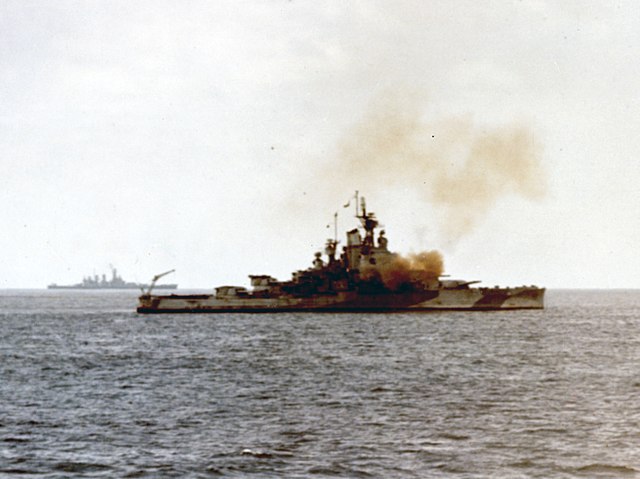
BB-36 shelling iwo Jima – the color photo shows part of the camouflage
post-war fate
Cecil C. Adell too command of Nevada on 28 October 1945, and she was back at Pearl Harbor after her stay in Tokyo Bay. A commission examined the ship ans estimated that after her 32 years of service she was no longer needed for post-war fleet, and assigned to be a target ship. In her new role, she was to be condicted in the Pacific to the Bikini atoll, infamous for the atomic experiments that took place under the name Operation Crossroads. It was the summer of July 1946, her captain had left command since the 1st of July, and USS Nevada was to be the bombardier’s primary target for the test ‘Able’, aiming directly at the ship with its unique A-bomb. Therefore, due to the altitude, Nevada’s decks were painted a reddish-orange. Despite of this, when the test started, the bomb fell about 1,700 yd (1,600 m) off the mark. It exploded just above the assault transport USS Gilliam instead and Nevada survived the blast.
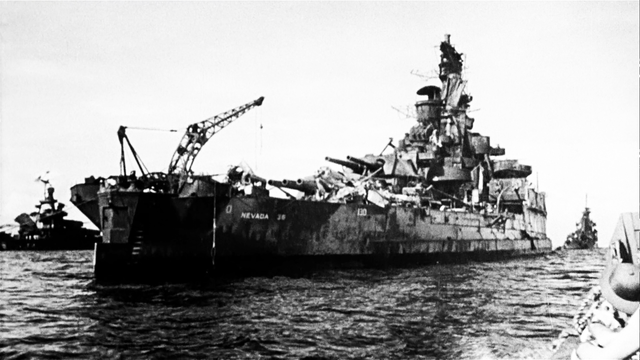
She remained afloat also after the “Baker” test, using a new method of underground explosion, 90 ft (27 m) below the surface. Due to the denser water, the schockwave damage the ship’s hull and radioactive fallout from the spray stuck to the ship. She was nevertheless towed to Pearl Harbor and formally decommissioned on 29 August 1946. After being closely examined, she was too dangerous to be scrapped and was instead used as a gunnery target practice, 65 miles southwest of Pearl Harbor. It was the 31 July 1948. Despite the battering she received, the valiant old battleship refused to sink and was eventually finished off by an aerial torpedo amidships.
A former main gun was preserved and is now displayed alongside a Missouri’s gun at the Wesley Bolin Memorial Plaza, east of the Arizona State Capitol complex (Phoenix). The memorial represents the Pacific War as a whole. A Replica at 1/15 scale of the USS Nevada was used for overhead shots of Battleship Row in the classic flick Tora! Tora! Tora!. She is today part of Los Angeles yearly parades for V-day, navy day and veteran day.

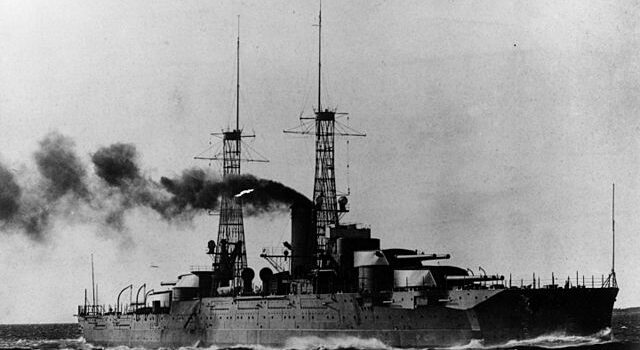
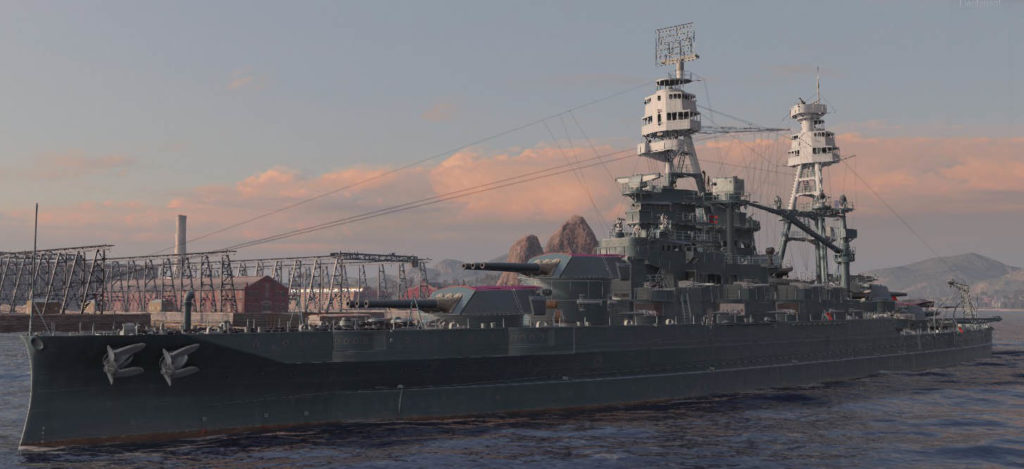
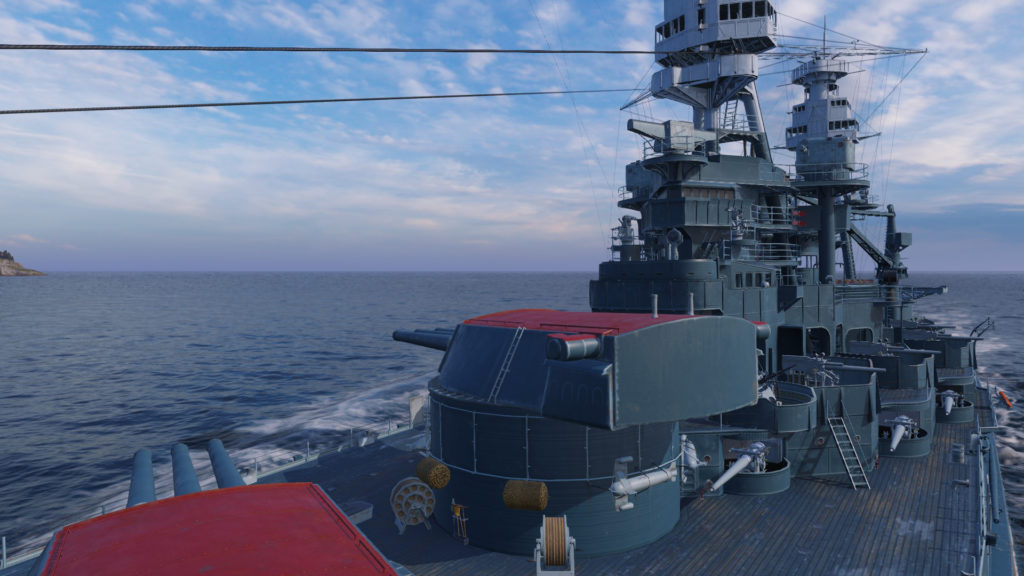
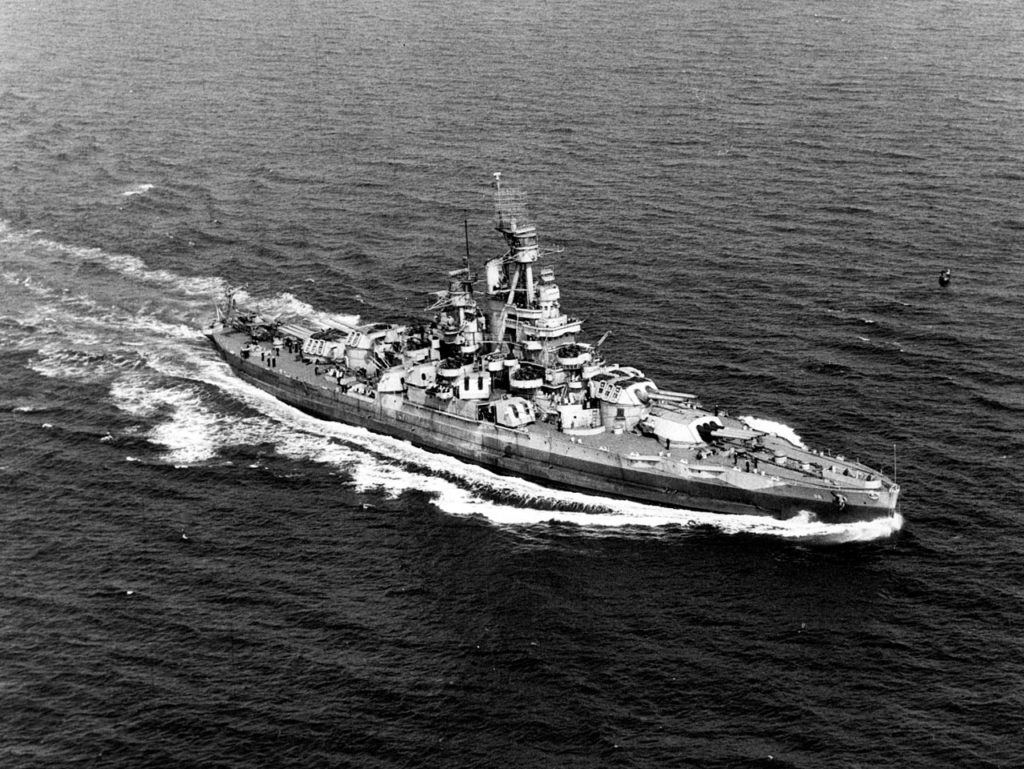
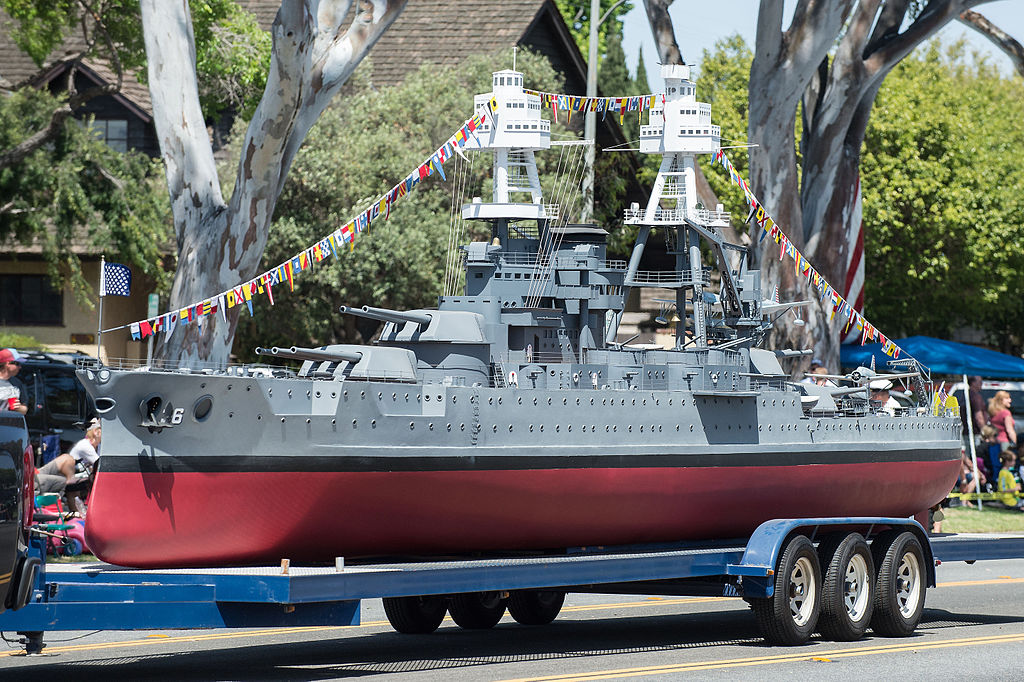
 Latest Facebook Entry -
Latest Facebook Entry -  X(Tweeter) Naval Encyclopedia's deck archive
X(Tweeter) Naval Encyclopedia's deck archive Instagram (@navalencyc)
Instagram (@navalencyc)





 French Navy
French Navy Royal Navy
Royal Navy Russian Navy
Russian Navy Armada Espanola
Armada Espanola Austrian Navy
Austrian Navy K.u.K. Kriegsmarine
K.u.K. Kriegsmarine Dansk Marine
Dansk Marine Nautiko Hellenon
Nautiko Hellenon Koninklije Marine 1870
Koninklije Marine 1870 Marinha do Brasil
Marinha do Brasil Osmanlı Donanması
Osmanlı Donanması Marina Do Peru
Marina Do Peru Marinha do Portugal
Marinha do Portugal Regia Marina 1870
Regia Marina 1870 Nihhon Kaigun 1870
Nihhon Kaigun 1870 Preußische Marine 1870
Preußische Marine 1870 Russkiy Flot 1870
Russkiy Flot 1870 Svenska marinen
Svenska marinen Søværnet
Søværnet Union Navy
Union Navy Confederate Navy
Confederate Navy Armada de Argentina
Armada de Argentina Imperial Chinese Navy
Imperial Chinese Navy Marinha do Portugal
Marinha do Portugal Mexico
Mexico Kaiserliche Marine
Kaiserliche Marine 1898 US Navy
1898 US Navy Sovietskiy Flot
Sovietskiy Flot Royal Canadian Navy
Royal Canadian Navy Royal Australian Navy
Royal Australian Navy RNZN Fleet
RNZN Fleet Chinese Navy 1937
Chinese Navy 1937 Kriegsmarine
Kriegsmarine Chilean Navy
Chilean Navy Danish Navy
Danish Navy Finnish Navy
Finnish Navy Hellenic Navy
Hellenic Navy Polish Navy
Polish Navy Romanian Navy
Romanian Navy Turkish Navy
Turkish Navy Royal Yugoslav Navy
Royal Yugoslav Navy Royal Thai Navy
Royal Thai Navy Minor Navies
Minor Navies Albania
Albania Austria
Austria Belgium
Belgium Columbia
Columbia Costa Rica
Costa Rica Cuba
Cuba Czechoslovakia
Czechoslovakia Dominican Republic
Dominican Republic Haiti
Haiti Hungary
Hungary Honduras
Honduras Estonia
Estonia Iceland
Iceland Eire
Eire Equador
Equador Iran
Iran Iraq
Iraq Latvia
Latvia Liberia
Liberia Lithuania
Lithuania Mandchukuo
Mandchukuo Morocco
Morocco Nicaragua
Nicaragua Persia
Persia San Salvador
San Salvador Sarawak
Sarawak Uruguay
Uruguay Venezuela
Venezuela Zanzibar
Zanzibar Warsaw Pact Navies
Warsaw Pact Navies Bulgaria
Bulgaria Hungary
Hungary

 Bundesmarine
Bundesmarine Dutch Navy
Dutch Navy Hellenic Navy
Hellenic Navy Marina Militare
Marina Militare Yugoslav Navy
Yugoslav Navy Chinese Navy
Chinese Navy Indian Navy
Indian Navy Indonesian Navy
Indonesian Navy JMSDF
JMSDF North Korean Navy
North Korean Navy Pakistani Navy
Pakistani Navy Philippines Navy
Philippines Navy ROKN
ROKN Rep. of Singapore Navy
Rep. of Singapore Navy Taiwanese Navy
Taiwanese Navy IDF Navy
IDF Navy Saudi Navy
Saudi Navy Royal New Zealand Navy
Royal New Zealand Navy Egyptian Navy
Egyptian Navy South African Navy
South African Navy






























 Ukrainian Navy
Ukrainian Navy dbodesign
dbodesign
I recommend to remove or replace those pictures which you titled as “Wows rendition of USS Nevada, 1941” as the ship on those pictures is not the USS Nevada but the USS Arizona. USS Nevada is not in World of Warships. However, USS Oklahoma is in the game so you can replace the Arizona screenshots with screenshots of WoWS’ rendition of the Oklahoma
Done, thanks !